Crimson-collared Tanager
It was first described by the French naturalist René-Primevère Lesson in 1831, its specific epithet from the Latin adjective sanguinolentus, bloodied, referring to its red plumage. This species is sometimes placed in a genus of its own as Phlogothraupis sanguinolenta,

Original source: john norton from Salt Lake City, USA
Author: john norton from Salt Lake City, USA
The Crimson-collared Tanager is classified as Least Concern. Does not qualify for a more at risk category. Widespread and abundant taxa are included in this category.
The Crimson-collared Tanager, Ramphocelus sanguinolentus, is a rather small Middle American songbird. It was first described by the French naturalist René-Primevère Lesson in 1831, its specific epithet from the Latin adjective sanguinolentus, "bloodied", referring to its red plumage. This species is sometimes placed in a genus of its own as Phlogothraupis sanguinolenta, and a genetic study suggests that it is less closely related to the other Ramphocelus tanagers than they are to each other. More
and belly (much like the Crimson-collared Tanager); the belly is mottled with black. Mature females have a black head and breast like males but greenish upperparts and yellowish underparts. Young birds are similar to females but have less black. The beak is black, big and stubby, with the upper mandible jutting roughly perpendicular to the forehead. The song is a warble, often slurred upward at the end. Calls are penetrating whistles starting with an "s" sound, slurred downward or one upward followed by one downward. More
Crimson-collared Tanager is usually seen in pairs while other members of the genus are normally found in small groups. This is a Central American endemic ranging along the Caribbean slope from S. Mexico to Panama. Two races are recognized. This is the slightly smaller, more southerly R. s. apricus. More
The Crimson-collared Tanager, Ramphocelus sanguinolentus, is a rather small Middle American songbird. Crimson-collared Tanagers average 19–20 cm (7.5–8 in) long. The adult plumage is black with a red collar covering the nape, neck, and breast (remarkably similar to the pattern of the male Crimson-collared Grosbeak). All tail coverts are also red. The bill is striking pale blue and the legs are blue-gray. Females average slightly duller than males, but are sometimes indistinguishable. More
Crimson-collared Tanager (Phlogothraupis sanguinolenta) photo Arenal, Guanacaste, Costa Rica April, 2009 More
Crimson-collared Tanager Phlogothraupis sanguinolenta = * Home Expand Log in Menu item Register Menu item Log out Menu item Change login details Menu item Why register? Expand UK & Ireland Menu item Birding sites More
The Crimson-collared Tanager is sometimes placed in a genus of its own as Phlogothraupis sanguinolenta (Howell and Webb 1994), and a genetic study suggests that it is less closely related to the other Ramphocelus tanagers than they are to each other (Hackett 1996). Its closest relative is Masked Crimson Tanager. The other species form two superspecies. One includes Crimson-backed, Huallaga, Silver-beaked and Brazilian Tanagers, and the other comprises Passerini's, Cherrie's and Flame-rumped Tanagers. More
Family : Thraupidae
Genus : Ramphocelus
Species : sanguinolentus
Authority : (Lesson, 1831)

